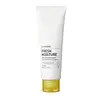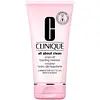What's inside
What's inside
 Key Ingredients
Key Ingredients

No key ingredients
 Benefits
Benefits

 Concerns
Concerns

No concerns
 Ingredients Side-by-side
Ingredients Side-by-side

Water
Skin ConditioningGlycerin
HumectantPotassium Myristate
EmulsifyingPotassium Laurate
EmulsifyingPotassium Stearate
CleansingMyristic Acid
CleansingLauryl Hydroxysultaine
CleansingPotassium Palmitate
EmulsifyingGlycol Distearate
EmollientLauric Acid
CleansingStearic Acid
CleansingPolyquaternium-22
Palmitic Acid
EmollientLimonene
PerfumingGuar Hydroxypropyltrimonium Chloride
Skin ConditioningCitrus Junos Peel Oil
AstringentDisodium EDTA
Cocos Nucifera Oil
MaskingButylene Glycol
HumectantCoco-Caprylate/Caprate
EmollientCitrus Junos Peel Extract
Skin ConditioningWater, Glycerin, Potassium Myristate, Potassium Laurate, Potassium Stearate, Myristic Acid, Lauryl Hydroxysultaine, Potassium Palmitate, Glycol Distearate, Lauric Acid, Stearic Acid, Polyquaternium-22, Palmitic Acid, Limonene, Guar Hydroxypropyltrimonium Chloride, Citrus Junos Peel Oil, Disodium EDTA, Cocos Nucifera Oil, Butylene Glycol, Coco-Caprylate/Caprate, Citrus Junos Peel Extract
Water
Skin ConditioningPotassium Myristate
EmulsifyingGlycerin
HumectantPotassium Behenate
CleansingSodium Methyl Cocoyl Taurate
CleansingPotassium Palmitate
EmulsifyingPotassium Laurate
EmulsifyingPotassium Stearate
CleansingPEG-3 Distearate
EmulsifyingCholesteryl Hydroxystearate
EmollientButylene Glycol
HumectantSodium Hyaluronate
HumectantTrisodium EDTA
Disodium EDTA
Phenoxyethanol
PreservativeCI 60730
Cosmetic ColorantCI 14700
Cosmetic Colorant
 Reviews
Reviews

Ingredients Explained
These ingredients are found in both products.
Ingredients higher up in an ingredient list are typically present in a larger amount.
Butylene Glycol (or BG) is used within cosmetic products for a few different reasons:
Overall, Butylene Glycol is a safe and well-rounded ingredient that works well with other ingredients.
Though this ingredient works well with most skin types, some people with sensitive skin may experience a reaction such as allergic rashes, closed comedones, or itchiness.
Learn more about Butylene GlycolDisodium EDTA plays a role in making products more stable by aiding other preservatives.
It is a chelating agent, meaning it neutralizes metal ions that may be found in a product.
Disodium EDTA is a salt of edetic acid and is found to be safe in cosmetic ingredients.
Learn more about Disodium EDTAGlycerin is already naturally found in your skin. It helps moisturize and protect your skin.
A study from 2016 found glycerin to be more effective as a humectant than AHAs and hyaluronic acid.
As a humectant, it helps the skin stay hydrated by pulling moisture to your skin. The low molecular weight of glycerin allows it to pull moisture into the deeper layers of your skin.
Hydrated skin improves your skin barrier; Your skin barrier helps protect against irritants and bacteria.
Glycerin has also been found to have antimicrobial and antiviral properties. Due to these properties, glycerin is often used in wound and burn treatments.
In cosmetics, glycerin is usually derived from plants such as soybean or palm. However, it can also be sourced from animals, such as tallow or animal fat.
This ingredient is organic, colorless, odorless, and non-toxic.
Glycerin is the name for this ingredient in American English. British English uses Glycerol/Glycerine.
Learn more about GlycerinWe don't have a description for Potassium Laurate yet.
We don't have a description for Potassium Myristate yet.
We don't have a description for Potassium Palmitate yet.
We don't have a description for Potassium Stearate yet.
Water. It's the most common cosmetic ingredient of all. You'll usually see it at the top of ingredient lists, meaning that it makes up the largest part of the product.
So why is it so popular? Water most often acts as a solvent - this means that it helps dissolve other ingredients into the formulation.
You'll also recognize water as that liquid we all need to stay alive. If you see this, drink a glass of water. Stay hydrated!
Learn more about Water